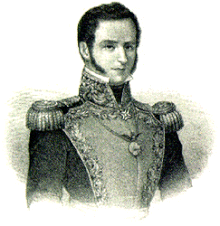José María Tornel
José María de Tornel y Mendívil | |
|---|---|
 | |
| Governor of the Federal District | |
| In office 24 November 1833 – 12 January 1835 | |
| Preceded by | José Ignacio Esteva |
| Succeeded by | |
| In office 23 February 1828 – 3 December 1828 | |
| Preceded by | |
| Succeeded by | José Ignacio Esteva |
| Governor of Veracruz | |
| In office 1828–1829 | |
| Preceded by | Miguel Barragán |
| Succeeded by | |
| Personal details | |
| Born | March 1, 1795 Orizaba, Veracruz, New Spain |
| Died | 1853 Tacubaya, Mexico City |
José María de Tornel y Mendívil (1795–1853) was a 19th-century Mexican army general and politician who greatly influenced the career of President Antonio López de Santa Anna.
Birth[]
José Maria Tornel y Mendívil was born March 1, 1795 in the town of Orizaba, Veracruz, New Spain to Julian Tornel, a prominent shopkeeper, and Manuela Jacinta Bernarda Mendívil Vidal.[1]
Career[]
Tornel was prominent among the "santanista,"[2] a group of politicians and officials who helped Santa Anna return to power frequently, despite defeats in the 1836 Texas Revolution and the 1846–48 Mexican–American War. Tornel advocated a federalist agenda in the 1820s. During that time, Tornel y Mendivil became Mexico's first president Guadalupe Victoria's right arm. Victoria named Tornel the Mexican ambassador to the United States in 1830.[3] His mission was to inform Victoria on Americans' ambitions to take Texas. He was a bitter enemy of American policies. He complained to the Jackson administration about its failure to honor Mexico’s laws prohibiting further migration of Americans to Texas. He also tried and failed to secure a firm boundary along the Sabine River. Thanks his reports, Victoria's government came victorious in the Fredonian Rebellion. Although Tornel supported federalism during the Victoria presidency, he changed his political views to support Santa Anna's reactionary dictatorship in the 1850s. He helped orchestrate the Plan of Cuernavaca revolt in 1834. Tornel served as Minister of War, and helped plan the campaign that led to the Battle of the Alamo.
He was the President of the Chamber of Deputies in 1828 and 1841.[4]
Works[]
- The "Tornel Decree" of December 30, 1835 (a key element in the Texas Revolution, giving Santa Anna license to execute all prisoners).[5]
- October 12, 1842 Speech to the Constituent Congress;[6]
- Military Expenses of Iniquity, Barbarism and Despotism of the Spanish Government, Executed in the Towns of Orizava and Córdoba;[7]
- Brief historical review of the most notable events in the Mexican nation;[8]
- Brief historical review of the most notable events of the Mexican nation: [from 1821 to the present day];[9]
- The Mexican Side of the Texas Revolution;[10]
References[]
- ^ Fowler 2000, p. 1.
- ^ Haynes et al. 2015, pp. 103.
- ^ Jackson & Wheat 2005, pp. 435–442.
- ^ Enciclopedia Política de México 9 Tomo V. (PDF). Senado de la República - Instituto Belisario Domínguez. 2010.
- ^ Fowler 2007, pp. 167, 169.
- ^ Tornel y Mendívil, José María (1842). Discurso pronunciado por el exmo. sr. general ministro de guerra y marina don José Maria Tornel en la sesión del 12 de octubre de 1842 del Congreso constituyente. en apoyo del dictamen de la mayorá de la comisión de constitucioń del mismo. Impr. de J. M. Lara – via HathiTrust.
- ^ Tornel y Mendívil, José María; Bustamante, Carlos María de (1843). Fastos militares de iniquidad, barbarie y despotismo del gobierno español, ejecutados en las villas de Orizava y Córdoba en la guerra de once años, por causa de la independencia y libertad de la nación mexicana, hasta que se consumó la primera por los tratados de Córdoba, celebrados por ... d. Agustin de Iturbide y d. Juan de O'Donoju. Dalos á luz como documentos que apoyan las relaciones del Cuadro historico de la revolucion, y a sus espensas ... Impreso por I. Cumplido – via HathiTrust.
- ^ Tornel y Mendívil, José María (1852). Breve reseña histórica de los acontecimientos más notables de la nación mexicana. Comisión Nacional para las Celebraciones del 175 Aniversario de la Independencia Nacional y 75 Aniversario de la Revolución Mexicana – via HathiTrust.
- ^ Tornel y Mendívil, José María (1853). Breve reseña histórica de los acontecimientos más notables de la nación mexicana: [desde el año de 1821 hasta nuestros días]. Instituto Nacional de Estudios Históricos de la Revolución Mexicana – via HathiTrust.
- ^ Santa Anna, Antonio López de; Castañeda, Carlos Eduardo; Tornel y Mendívil, José María; Urrea, José; Filísola, Vicente.; Martínez Caro, Ramón. (1970). The Mexican side of the Texas Revolution, 1836. Graphic Ideas – via HathiTrust.
Bibliography[]
- Fowler, Will (2000). Tornel and Santa Anna: The Writer and the Caudillo, Mexico, 1795–1853. Westport, Conn.: Greenwood Press. ISBN 0-313-30914-0.[dead link]
- Fowler, Will (2007). Santa Anna of Mexico. University of Nebraska Press. ISBN 978-0-8032-5646-0 – via Project MUSE.
- Haynes, Sam W.; Saxon, Gerald D.; Cantrell, Gregg; Schlereth, Eric (2015). Contested Empire: Rethinking the Texas Revolution. Texas A&M University Press. ISBN 978-1-62349-310-3 – via Project MUSE.
- Jackson, Jack; Wheat, John (2005). Almonte's Texas: Juan N. Almonte's 1834 Inspection, Secret Report & Role in the 1836 Campaign. Denton, TX: Texas State Historical Association. ISBN 978-0-87611-207-6 – via Portal to Texas History.
Further reading[]
- Winders, Richard Bruce (April 4, 2017). ""This Is A Cruel Truth, But I Cannot Omit It": The Origin and Effect of Mexico's No Quarter Policy in the Texas Revolution". Southwestern Historical Quarterly. 120 (4): 412–439. doi:10.1353/swh.2017.0000. ISSN 1558-9560. S2CID 151940992.
- 1795 births
- 1853 deaths
- Mexican people of Basque descent
- Presidents of the Chamber of Deputies (Mexico)
- People of Mexican side in the Texas Revolution
- Mexican military personnel of the Mexican–American War
- North American military personnel stubs
- Mexican people stubs
- Mexican military stubs
- Mexican politician stubs